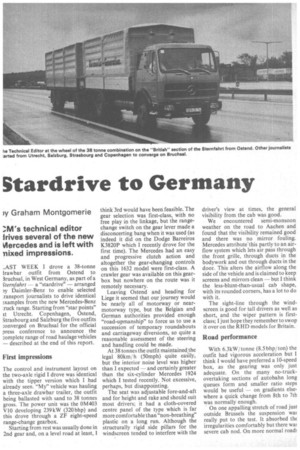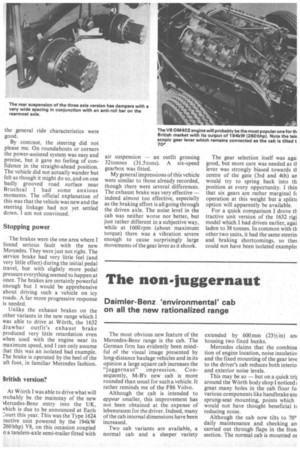Stardrive to Germany
Page 46

Page 47

If you've noticed an error in this article please click here to report it so we can fix it.
)y Graham Montgomerie technical editor 'rives several of the new Wercedes and is left with nixed impressions.
-AST WEEK I drove a 38-tonne lrawbar outfit from Ostend to 3ruchsal, in West Germany, as part of a S'ternfahrt — a "stardrive" — arranged )y Daimler-Benz to enable selected ransport journalists to drive identical xamples from the new Mercedes-Benz :ruck range. Starting from "star points" tt Utrecht. Copenhagen, Ostend, 3trasbourg and Salzburg the five outfits converged on Bruchsal for the official press conference to announce the complete range of road haulage vehicles — described at the end of this report.
First impressions
The control and instrument layout on the two-axle rigid I drove was identical with the tipper version which I had already seen. "My" vehicle was hauling a three-axle drawbar trailer, the outfit being ballasted with sand to 38 tonnes gross. The power unit was the 0M403 V10 developing 239 kW (320 bhp) and this drove through a 2F eight-speed range-change gearbox.
Starting from rest was usually done in 2nd gear and, on a level road at least, I think 3rd would have been feasible. The gear selection was first-class, with no free play in the linkage, but the rangechange switch on the gear lever made a disconcerting bang when it was used (as indeed it did on the Dodge Barreiros K3820P which I recently drove for the first time). The Mercedes had an easy and progressive clutch action and altogether the gear-changing controls on this 1632 model were first-class. A crawler gear was available on this gearbox but nowhere on the route was it remotely necessary.
Leaving Ostend and heading for Liege it seemed that our journey would be nearly all of motorway or nearmotorway type, but the Belgian and German authorities provided enough "road-upmanship" to force us to use a succession of temporary roundabouts and carriageway diversions, so quite a reasonable assessment of the steering and handling could be made.
At 38 tonnes the outfit maintained the legal 80km/ h (50mph) quite cagily, but the interior noise level was higher than I expected — and certainly greater than the six-cylinder Mercedes 1924 which I tested recently. Not excessive, perhaps, but disappointing.
The seat was adjustable fore-and-aft and for height and rake and should suit most drivers; it had a cloth-covered centre panel of the type which is far more comfortable than "non-breathing" plastic on a long run. Although the structurally rigid side pillars for the windscreen tended to interfere with the driver's view at times, the general visibility from the cab was good.
We encountered semi-monsoon weather on the road to Aachen and found that the visibility remained good and there was no mirror fouling. Mercedes attribute this partly to an airflow system which lets air pass through the front grille, through ducts in the bodywork and out through ducts in the door. This alters the airflow along the side of the vehicle and is claimed to keep screens and mirrors clean — but I think the less-blunt-than-usual cab shape, with its rounded corners, has a lot to do with it.
The sight-line through the windscreen is good for tall drivers as well as short, and the wiper pattern is firstclass; I just hope they remember to swop it over on the RHD models for Britain.
Road performance
With 6.3kW1 tonne (8.5 bhp/ ton) the outfit had vigorous acceleration but I think I would have preferred a 10-speed box, as the gearing was only just adequate. On the many no-truckovertaking sections of autobahn long queues form and smaller ratio steps would be useful — on gradients elsewhere a quick change from 8th to 7th was normally enough.
On one appalling stretch of road jusi outside Brussels the suspension ww really put to the test. It absorbed thc irregularities comfortably but there ww severe cab nod. On more normal roach the general ride characteristics were good.
By contrast, the steering did not please me. On roundabouts or corners the power-assisted system was easy and precise, but it gave no feeling of confidence in the straight-ahead position. The vehicle did not actually wander but felt as though it might do so, and on one badly grooved road surface near Bruchsal I had some anxious moments. The official explanation of this was that the vehicle was new and the steering linkage had not yet settled down. I am not convinced.
Stopping power
The brakes were the one area where I found serious fault with the new Mercedes. They were just not right. The service brake had very little feel (and very little effect) during the initial pedal travel, but with slightly more pedal pressure everything see med to happen at once. The brakes are certainly powerful enough but I would be apprehensive about driving such a vehicle on icy roads. A far more progressive response is needed.
Unlike the exhaust brakes on the other variants in the new range which I was able to drive at Worth, the 1632 Jrawbar outfit's exhaust brake produced very little retardation even when used with the engine near its maximum speed, and I can only assume hat this was an isolated bad example. The brake is operated by the heel of the .eft foot, in familiar Mercedes fashion.
British version?
At Worth I was able to drive what will )robably be the mainstay of the new viercedes-Benz entry into the UK, vhich is due to be announced at Earls L'ourt this year. This was the Type 1624 ractive unit powered by the 194kW 260 bhp) V8, on this occasion coupled o a tandem-axle semi-trailer fitted with air suspension — an outfit grossing 32 tonnes (31.5 tons). A six-speed gearbox was fitted.
My general impressions of this vehicle were similar to those already recorded, though there were several differences. The exhaust brake was very effective — indeed almost too effective, especially as the braking effort is all going through the driven axle. The noise level in the cab was neither worse nor better, but just rather different in a subjective way, while at 1600 rpm (about maximum torque) there was a vibration severe enough to cause surprisingly large movements of the gear lever as it shook. The gear selection itself was aga] good, but more care was needed as t1 lever was strongly biased towards ti centre of the gate (3rd and 4th) an would try to spring back into th position at every opportunity. I thin that six gears are rather marginal ft operation at this weight but a splitt( option will apparently be available.
For a quick comparison I drove th tractive unit version of the 1632 rigi model which I had driven earlier, agai laden to 38 tonnes. In common with th other two units, it had the same steerin and braking shortcomings, so thes could not have been isolated example




































































































































